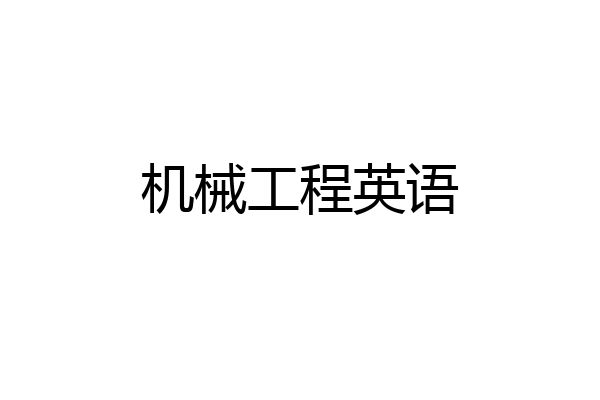 艾吃艾美
艾吃艾美
共5条回答104浏览
-
-

Historically,this novel principle first came into being here in the United States in 1920,纵观历史,成组技术这种新颖的生产方式在1920年诞生于美国,when Frederick Taylor supoortsd the idea of grouping that required special operations.在Frederick Taylor提出需要特殊操作的分组的想法的时候。He was followed by the Jones and Lamson Machine Company in the early 1920s,这一想法在19世纪20年代初得到了约翰.兰逊机械公司的支持,which used a crude form of group tecnology to build machine tools. 他们使用了一种原始的分组技术来制造机械工具。Today,group technology is implemented through the application of well-structured classification and coding systems and supporting software to take advantage of the similarities of components. 时至今日,成组技术已经被广泛应用于具有良好结构的分类系统,编码系统和用来支持软件对部件相似性的利用。Reasons for adopting Group Technology 采用成组技术的理由Modern manufacturing industries are racing a lot of challenges caused by growing international competition and fast-changing market demands.由于不断增长的全球化竞争和瞬息万变的市场需求,现代化的制造业面临着大量的挑战。These challenes,which are exemplified in the following list,have been and can be successfully met by group technology: 我们将以下述挑战为例,来说明成组技术如何进行应对:As a result of the first factor,the conventional shop organization(i.e.,departmentalization by process) is becoming very inefficient and obsolete bacause of the wasteful routing paths of the products between the various machine tool departments. 由于首要因素的限制,传统的车间式组织(例如,根据生产工艺进行分部门组织)由于产品在不同机械工具部门之间的浪费路径而变得极其低效。There is a need integrate the design and manufacturing phases in order to cut short the lead time,thus winning a competitive situation in the international market.因此需要对设计及制造各部分进行整合以缩短交货时间,并以此在国际市场创造更具有竞争力的局面。问题补充:(1)Benefits in product desing. Concerning design of products,the principal benefit of group technology is that it enables product designer to avoid “reinventing the wheel”, or duplicating engineering efforts. In other words, it eliminates the possibility of desiging a product that was previously designed because it facilitates storage and easy retrieval of engineering designs. 问题补充:(1)对产品设计的益处对于产品设计,成组技术的首要好处就在于它避免了设计者的重复劳动,或者说它复制了工程成果。换种说法:成组技术通过促进对工程设计的储存和重获,避免了设计出一个与以前设计产品类似的可能性。If the exact part design is not included in company’s computerized files, a design close enough to the required one can be retrieved and modified in order to satisfy the requirements.A further advantage of group technology is that it promotes standardization of design features, such as corner radii, chamfers,and the like, thus leading to the standardization of production tools and work-holding devices.即使具体零件的设计并不包含在公司的电脑档案,也可以通过成组技术获取一个跟所需设计足够接近的产品设计,并通过改进来使它满足要求。成组技术的另一更大的好处是它促进了设计数据的标准化,像是转弯半径,倒角这些,并使得生产工具和夹具标准化。
-
-
-
College of Mechanical Engineering
-
-
-
I don't know!!
-
-
 皛白白皛12小时前发布
皛白白皛12小时前发布-
本书共16个单元,内容包括机械工程基础(工程材料及其处理、绘图、公差、机械原理、机械零件、热加工和成型技术等),机械加工设备与技术,计算机化制造技术和机电一体化技术(涉及数控技术、工业机器人、计算机辅助设计与制造、柔性制造和成组技术等),装配,农业机械(涉及常用的动力机械如汽油机和柴油机,常用的农业机械如拖拉机)。本书内容的选取均为国内外报刊、杂志、教材、论著和其他文选,内容编排按照学生学习专业知识的过程循序渐进,有连贯性,英语语言由浅入深,有系统性。每个单元围绕一个主题(theme)编选课文和练习题。本书可作为高等工科院校学生教学用书,并可供机械、机械电子、车辆等行业的科研、工程技术人员参考。本书有配套电子教案,可赠送给用本书作为授课教材的院校和老师,如有需要,可发邮件至hqlbook@126?com索取。简 介:本书系统地介绍了机械制图、机械原理、机械设计、公差、液压、金属材料、热处理、铸造、锻压、焊接、金属切削机床、刀具、夹具、计算机辅助设计、计算机辅助制造、柔性制造系统、计算机辅助编程、电火花加工、质量控制、数控原理与加工、制造管理等方面的专业英语知识和术语。全书分5部分,共45单元,每个单元包括课文、生词及专业词汇注释、长难句解析、课后练习题、趣味阅读等内容。本书配有精美课件、习题答案等教学资源,供任课教师选用,以方便教学、提高教学质量。目 录:目 录Unit 1 Engineering Drawings and ToleranceUnit 2 Dimensional Tolerances and Surface RoughnessUnit 3 Basic Concepts in MechanicsUnit 4 Movement AnalysisUnit 5 Kinematic SynthesisUnit 6 Fundamentals ofMechanical DesignUnit 7 MechanismUnit 8 GearsUnit 9 BearingUnit 10 Hydraulic System and Its ElementsUnit 11 Industrial Hydraulic CircuitsUnit 12 Engineer MaterialUnit 13 Hot Metalworking Processing (I)Unit 14 Hot Metalworking Processing (Ⅱ)Unit 15 Characteristics of Mass-Reducing ProcessesUnit 16 Chip FormationUnit 17 The Tool Material and The Tool GeometryUnit 18 The Surface QualityUnit 19 The Single-point Cutting ToolsUnit 20 The Multipoint Cutting ToolsUnit 21 LathesUnit 22 Jigs and FixturesUnit 23 Advantages of CNCUnit 24 Construction of Machine ToolsUnit 25 Machining CentersUnit 26 Principles of Operation of NC Machine ToolsUnit 27 Part ProgramsUnit 28 OperationUnit 29 Computer-aided Design(CAD)Unit 30 Computer-aided Manufacturing(CAM)Unit 31 Computer Aided Process PlanningUnit 32 Flexible Manufacturing SystemUnit 33 Computer Integrated Manufacturing SystemUnit 34 Agile ManufacturingUnit 35 The Electrical Discharge Machining ProcessUnit 36 Quality Control and AssuranceUnit 37 IntroductionUnit 38 Inventory Control: From EOQ to ROPUnit 39 The MRP CrusadeUnit 40 The JIT RevolutionUnit 41 A Science of ManufacturingUnit 42 Total Quality ManufacturingUnit 43 Production SchedulingUnit 44 Supply Chain ManagementUnit 45 Capacity Management附录A How to Write the English Resume参 考 文 献
-
-
 奇异果香12小时前发布
奇异果香12小时前发布-
机械强度。一种材料可以遭受很多不同种类的作用力。他们可能是拉力,剪力,压力或者是他们的联合。每个可能的力造成材料的不同回应方式。因此,一种有几个不同的“机械强度”。这些强度是建立在说加载的载荷上的。最典型的机械强度有:A、抗拉强度 一种材料在断裂前能抵抗的最大拉应力。抗拉强度是最容易测量的强度,因此,它被广泛的应用。B、抗压强度 抵抗挤压材料变成新形状趋向应力的能力。从根本上是与抗拉强度相反的。极大的挤压应力会造成材料破裂。C、剪应力 抵抗在遭受剪应力断裂的能力。大小相等的力作用于相反的方向时会产生剪应力。这些力会造成材料的晶粒或者分子从这个滑动到那个上,最后断裂。D、抗扭强度 抵抗切向应力的能力。超过抗扭强度的力会使材料断裂。E、抗弯强度 材料抵抗拉应力和压应力共同作用的能力。由图1.2可以看到,当弯曲一个材料时,被弯曲材料的内部肯定受压,以此同时,外面的部分被拉伸。当遭到弯矩时,材料肯定出现抗弯强度。F、疲劳强度 抵抗方向变力。造成疲劳的典型应力为往复来回地变动的恒力。??????或者弯应力。G、抗“冲击强度”(不够专业的翻译) 抵抗忽然迅速加上载荷的能力。它是抗拉强度和抗压强度更具体的测量。冲击强度决定了吸收迅速加上的拉力或者压力的能力。锻模必须有很高的抗冲击强度。(3)材料的塑性流动 除了涉及强度的机械性能外,材料有统治他们在塑性变形阶段行为的特征。这些性能通常被称为延展性和CREEP。延展性是材料普通温度下粘性流动的特征。越高的延展性越高的可加工性(没有断裂发生的)。高延展性的材料容易弯曲,拉成电线或者拉伸成实体。
-


